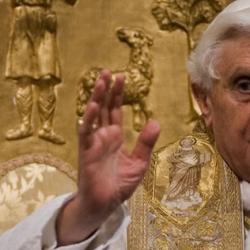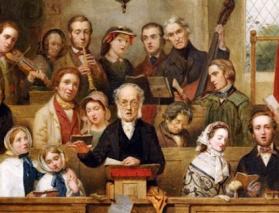Jeremy Begbie has pointed out that, though a physical phenomena, music has different spatial qualities than solid objects. Music is present in a place, but it’s not localized in a way a visually perceptible object is. I can give my attention to listening to the sound, but I can’t say it’s “here” or “there” or “not here.” “What I hear occupies the whole of my aural space,” so that the acoustic world, with very slight variations, stays the same no matter what direction I turn. Aural space is a space, since I can eventually move far enough away from the sound source that I no longer hear it. But it is a space where objects are not locatable, and therefore provides a neat set of illustrations of theological realities.
Begbie uses musical categories to speak of perichoresis:
“When more than one sound is present, occupying the same space while remaining audibly distinct, we may speak of a space not of mutual exclusive but of ‘interpenetration.’ Sounds do not have to ‘cut each other off’ or obscure each other, in the manner of visually perceived objects. The tones of a chord can be heard sounding through each other. In the acoustic realm, in other words, there is no neat distinction between a place and its occupant.” Later he writes, “Music directly ‘pulls the strings,’ so to speak, of the spatial framework in which it is deployed – no neat divine marks off occupant and place in musical experience. We need only to think of a three-tone major chord, which we hear as three distinct, mutually enhancing (not mutually exclusive) sounds, but together occupying the same aural space.” Sounds occupy the space created by other sounds, and in occupying that space also create space for the sounds in which they exist. Each envelops each.
In Resounding Praise , he draws the Trinitarian implications directly: “What could be more apt than to speak of the Trinity as a three-note chord, a resonance of life; Father, Son, and Spirit mutually indwelling, without mutual exclusion, and yet without merger, each occupying the same space, ‘sounding through’ one another, yet irreducibly distinct, reciprocally enhancing, and establishing one another as other?”
To say that the Persons are in perichoretic communion is to say that God is music. To say that world is created as a tangled image of God’s perichoretic fellowship is to say that the world is musical. And once we notice the perichoretic character of sound, we can begin to discern a musical quality in the world as a whole. Even visually, things have a certain perichoretic quality. I see the table and the table setting as distinct, but the table is the “chord” in which the “melody” of the table setting sounds, and the table setting’s melody enlivens the chord of the table. Each element of the table setting is contextualized by, and contextualizes the rest.











